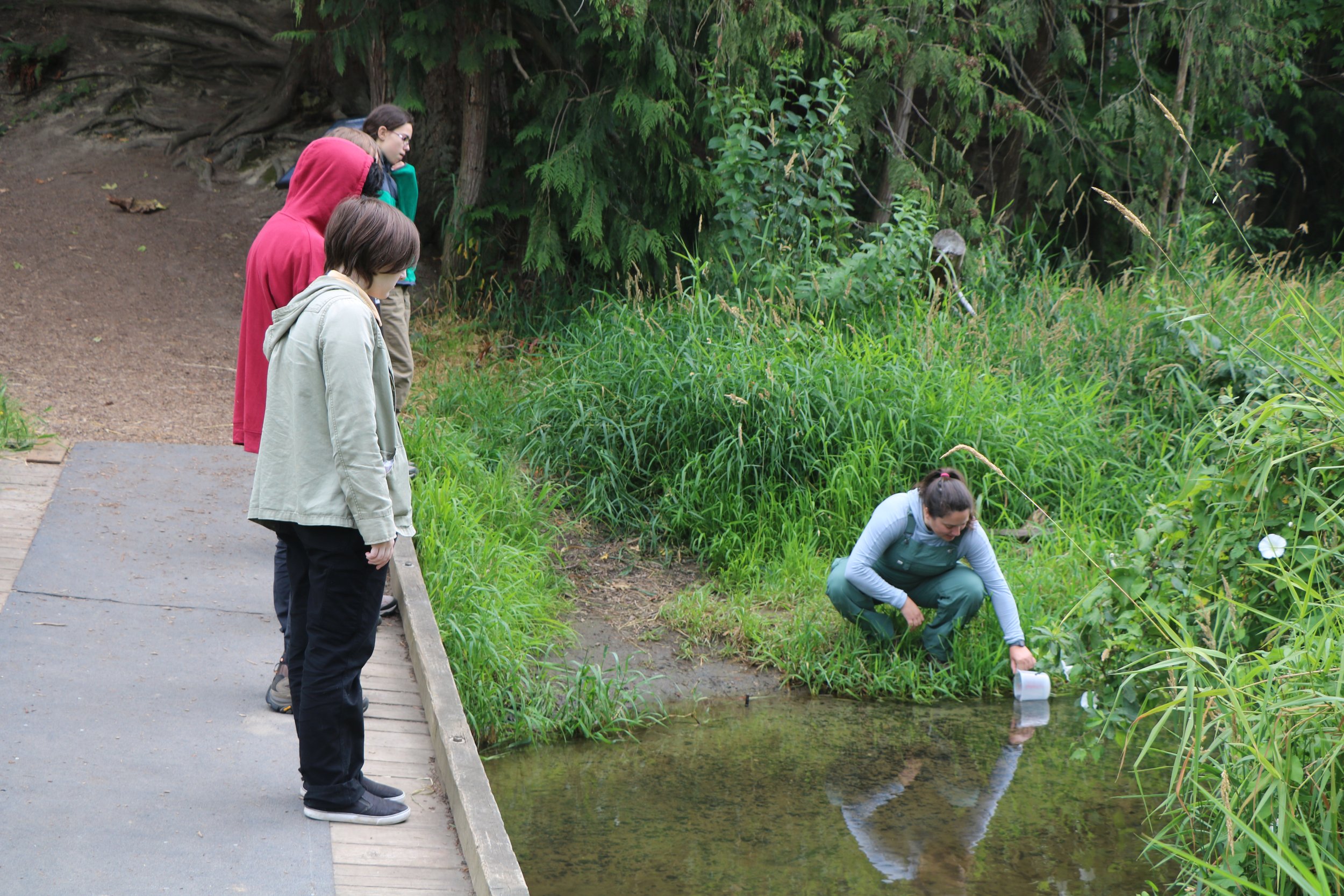Youth Explore the Science Behind Native Plants and Water Quality
/It was a beautiful, sunny July morning when ten Snohomish County high school students bounded down the well-traveled trails of Marysville’s Jennings Park and into the Allen Creek floodplain. These students are participants of Snohomish Conservation District’s brand new Youth Engaged in Sustainable Systems (YESS) program, a five-week curriculum exploring careers in natural resources while building job skills and earning summer school credit.
Environmental Educator Brianna Bjolstad pictured demonstrating a water test.
Water quality was the topic of the day and Allen Creek was its subject. After an opening stretching circle, Alana Springer, the District’s Environmental Education Program Manager, asked for a show of hands if anyone had done water quality testing before. To her delight, about half of the participants raised their hands. After collecting samples from the creek, District Environmental Educator Brianna Bjolstad led students through a series of tests to measure the temperature, pH, dissolved oxygen, phosphate, and turbidity levels of Allen Creek’s water. Those test results helped set the stage for understanding the students’ afternoon activity of stomping out reed canary grass to make room for native species that promote water quality.
Students work on water quality test.
You might be familiar with Jennings Park, the centerpiece to the City of Marysville’s extensive parks system. The park is a gem, containing 30 acres of forest, wetlands, and trails connecting playgrounds, picnic areas, a WSU Extension Master Garden, and more. Jennings Park also includes a segment of Allen Creek, a tributary of the Snohomish River Estuary that empties into Ebey Slough after passing through the Qwuloolt Estuary Restoration Project completed by the Tulalip Tribes in 2015.
Allen Creek is a salmon-bearing stream, home to Chinook salmon and steelhead (both of which are listed as threatened under the Endangered Species Act), and coho, chum, and pink salmon. Unfortunately, the Allen Creek watershed has lost much of its natural function and the creek was listed as an impaired stream by the Washington Department of Ecology in 1997 for low dissolved oxygen levels.
A deer wandered out from the brush during the lesson and delighted the students.
Much of the Allen Creek floodplain has been dominated by invasive plant species like reed canary grass that do not provide enough cover to fully shade the creek, thereby increasing the water temperature. High water temperatures lead to low dissolved oxygen levels, which can be lethal for fish. Salmon need slow, cool water to survive and make the passage to their spawning grounds. Allen Creek was also found to have fecal coliform bacteria and excessive levels of zinc.
Starting in 2018, the District has worked to improve water quality in Allen Creek by planting native plants in the floodplain. We planted native, woody vegetation, mainly willows and cottonwood to overcome the invasive reed canary grass and nightshade dominating the area. As the willows and cottonwood grow, they will provide shade to Allen Creek, lowering water temperatures and shading out the invasive plants, thus slowing their growth.
These planting projects came with a variety of unique challenges. To start, Allen Creek is a tidally-influenced creek, affected by the ebb and flow of ocean tides. The constant change in water level made it difficult to work in and hard for new plants to establish their roots. Another concern was how the salinity of the creek would affect “restoration superstar” native tree and shrub species that are typically planted in project sites infested with reed canary grass. Yet another challenge to planting Allen Creek was the reed canary grass itself. Not only is reed canary grass a strong competitor to native plants, but the thick grass obscured soil erosion occurring along the banks of Allen Creek and across the floodplain, creating hidden water pits that posed a challenge for field crews. To properly plant the floodplain, we needed a mobile vessel to transport our planting material. The District now has a boat that helped navigate planting in the floodplain and can be used in future projects.
The District planted over 27,000 native trees and shrubs on 23 acres of streamside habitat in the Allen Creek floodplain. Most plants survived, and one way to help ensure their continued survival is through regular maintenance, including stomping down reed canary grass.
This brings us back to the sunny morning in Jennings Park with YESS program participants. Their water quality tests suggested that while the water temperature was still a bit too high for salmon, the stream is healing. These test results reinforced the importance of the afternoon’s activity of stomping out reed canary grass to make room for native willow and cottonwood trees that will one day provide much-needed shade to the creek.
Snohomish Conservation District’s brand new YESS (Youth Engaged in Sustainable Systems) program connects youth with the great outdoors, providing the opportunity to explore different conservation careers. YESS high school participants earn summer school credit while building their job skills and exploring careers in natural resources. Over their five to six weeks in the program, students’ classroom time is paired with hands-on service activities at restoration sites.
This project was funded in part by the Department of Ecology.
















